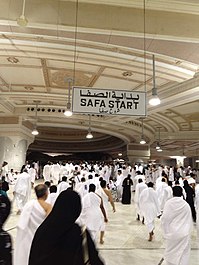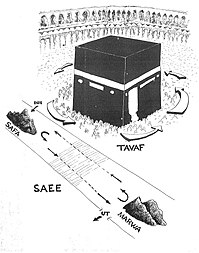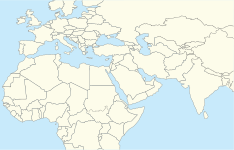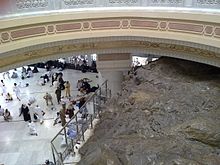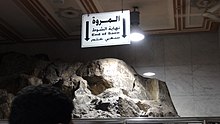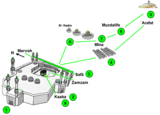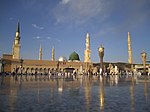
Mecca is the capital of Mecca Province in the Hejaz region of western Saudi Arabia and the holiest city in Islam. It is 70 km (43 mi) inland from Jeddah on the Red Sea, in a narrow valley 277 m (909 ft) above sea level. Its last recorded population was 2,385,509 in 2022. Its metropolitan population in 2022 is 2.4 million, making it the third-most populated city in Saudi Arabia after Riyadh and Jeddah. Around 44.5% of the population are Saudi citizens and around 55.5% are foreigners from other Muslim countries. Pilgrims more than triple the population number every year during the Ḥajj pilgrimage, observed in the twelfth Hijri month of Dhūl-Ḥijjah. With over 10.8 million international visitors in 2023, Mecca was one of the 10 most visited cities in the world.

Abū ʿAbd Allāh Muḥammad ibn Ismāʿīl ibn Ibrāhīm al-Juʿfī al-Bukhārī was a 9th-century Muslim muhaddith who is widely regarded as the most important hadith scholar in the history of Sunni Islam. Al-Bukhari's extant works include the hadith collection Sahih al-Bukhari, al-Tarikh al-Kabir, and al-Adab al-Mufrad.

According to the Book of Genesis, Hagar was an Egyptian slave, a handmaiden of Sarah, whom Sarah gave to her own husband Abram as a wife to bear him a child. Abraham's firstborn son, through Hagar, Ishmael, became the progenitor of the Ishmaelites, generally taken to be the Arabs. Various commentators have connected her to the Hagrites, perhaps claiming her as their eponymous ancestor. Hagar is alluded to, although not named, in the Quran, and Islam considers her Abraham's second wife.

Bakkah, is a place mentioned in surah 3, ayah 96 of the Qur'an, a verse sometimes translated as: "Surely the first House ˹of worship˺ established for humanity is the one at Bakkah—a blessed sanctuary and a guide for ˹all˺ people."

Sahih al-Bukhari is the first hadith collection of the Six Books of Sunni Islam. It was compiled by Uzbek scholar al-Bukhari around 846. The author was born in Bukhara in today's Uzbekistan.

The Umrah is an Islamic pilgrimage to Mecca, the holiest city for Muslims, located in the Hejazi region of Saudi Arabia. It can be undertaken at any time of the year, in contrast to the Ḥajj, which has specific dates according to the Islamic lunar calendar.
In Twelver Shia Islam, the Ancillaries of the Faith are a set of practices that Shia Muslims have to carry out.

۩ Sujūd, or sajdah, also known as sijda,sejda or shejda is the act of low bowing or prostration to (God) facing the qiblah. It is usually done in standardized prayers (salah). The position involves kneeling and bowing till one touches the ground with 7 bones (points): the forehead & nose, two hands, two knees and two sets of toes. In accordance with the Sunnah of Muhammad, one's elbows should be far from one's body, unless it causes discomfort to other worshippers. Some scholars hold the position that this applies only to men, and that women are encouraged to tuck their elbows in out of modesty,

The miqat is a principal boundary at which Muslim pilgrims intending to perform the Ḥajj or ʿUmrah must enter the state of iḥrām, a state of consecration in which certain permitted activities are made prohibited.
The Farewell Pilgrimage refers to the one Hajj pilgrimage that Muhammad performed in the Islamic year 10 AH, following the Conquest of Mecca. Muslims believe that verse 22:27 of the Quran brought about the intent to perform Hajj in Muhammad that year. When Muhammad announced this intent, approximately 100,000 of his Sahaba gathered in Medina to perform the annual pilgrimage with him. Muhammad performed Hajj al-Qiran.
A famous recorded oral tradition among Muslims is about comment made by Imran ibn Husain, one of the companions of Muhammad and a Narrator of hadith. The comment was regarding the prohibition of Mut'ah, a word with several meanings. It is used in both Nikah mut'ah and Mut'ah of Hajj.
The Pledge of the Tree was a pledge that was sworn to the Islamic prophet Muhammad by his companions prior to the Treaty of al-Hudaybiya. The pledge, sworn under a tree, was to avenge the rumoured death of Uthman.
Hājar, known as Hagar in the Hebrew Bible, was the wife of the patriarch and Islamic prophet Ibrahim (Abraham) and the mother of Ismā'īl (Ishmael). She is a revered woman in the Islamic faith. According to Muslim belief, she was the daughter of the king of Egypt who gifted her to Ibrahim's wife Sarah. Although not mentioned by name in the Qur'an, she is referenced and alluded to via the story of her husband. She eventually settled in the Desert of Paran, seen as the Hejaz in the Islamic view, with her son Ishmael. Hajar is honoured as an especially important matriarch of monotheism, as Ishmael was the ancestor of Muhammad....

The Zamzam Well is a well located within the Masjid al-Haram in Mecca, Saudi Arabia. It is located 20 m (66 ft) east of the Kaaba, the holiest place in Islam.

The Kaaba, sometimes referred to as al-Ka'ba al-Musharrafa, is a stone building at the center of Islam's most important mosque and holiest site, the Masjid al-Haram in Mecca, Saudi Arabia. It is considered by Muslims to be the Bayt Allah and is the qibla for Muslims around the world. The current structure was built after the original building was damaged by fire during the siege of Mecca by Umayyads in 683 AD.
Islam is an Abrahamic monotheistic religion teaching that there is only one God (Allah) and that Muhammad is His last Messenger.

Hajj is an annual Islamic pilgrimage to Mecca, Saudi Arabia, the holiest city for Muslims. Hajj is a mandatory religious duty for Muslims that must be carried out at least once in their lifetime by all adult Muslims who are physically and financially capable of undertaking the journey, and of supporting their family during their absence from home.
Ishmael is regarded as a prophet and the ancestor to the Ishmaelites in Islam. He is the son of Ibrahim, born to Hajar. Ismail is also associated with Mecca and the construction of the Kaaba. Ismail is considered the ancestor to Muhammad.
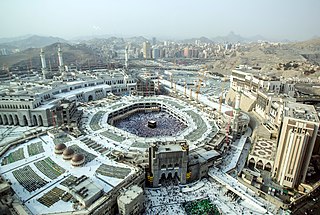
Masjid al-Haram, also known as the Sacred Mosque or the Great Mosque of Mecca, is considered to be the most significant mosque in Islam. It encloses the vicinity of the Kaaba in Mecca, in the Mecca Province of Saudi Arabia. It is among the pilgrimage sites associated with the Hajj, which every Muslim must perform at least once in their lives if able. It is also the main site for the performance of ʿUmrah, the lesser pilgrimage that can be undertaken any time of the year. The rites of both pilgrimages include circumambulating the Kaaba within the mosque. The Great Mosque includes other important significant sites, such as the Black Stone, the Zamzam Well, Maqam Ibrahim, and the hills of Safa and Marwa.
Manasik is the whole of rites and ceremonies that have to be performed by Islamic pilgrims in and around Mecca. The Qur'an differentiates between two manasiks: The Manasik of Hajj, has to be done in the month Dhu al-Hijjah and The Manasik of ʿUmra, which can be performed any time of the year. The knowledge of manasik is an independent part of Fiqh.
